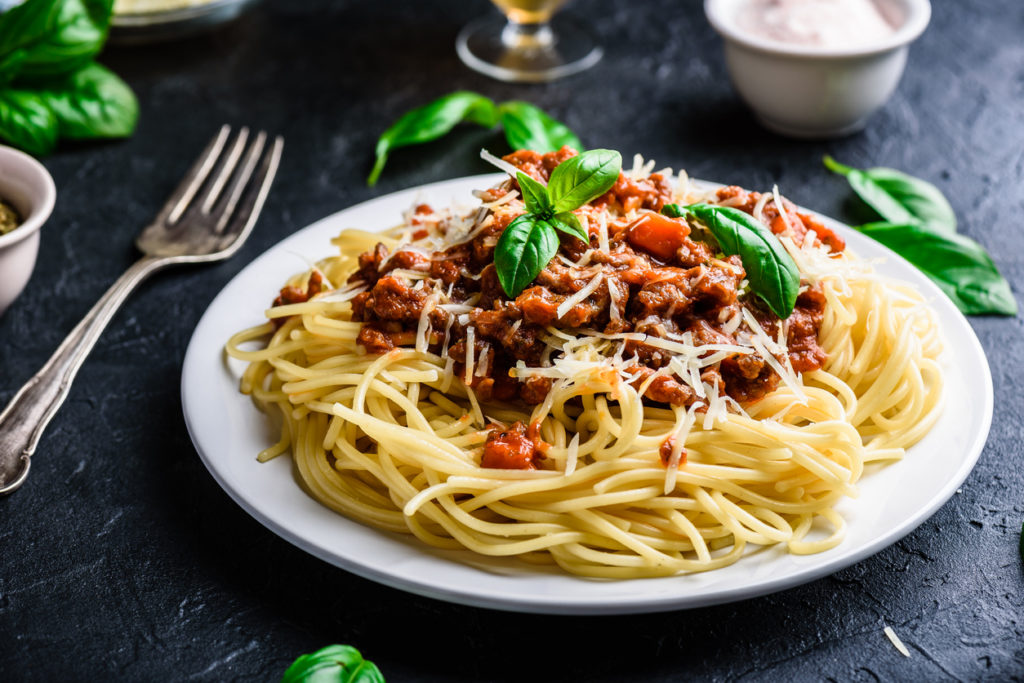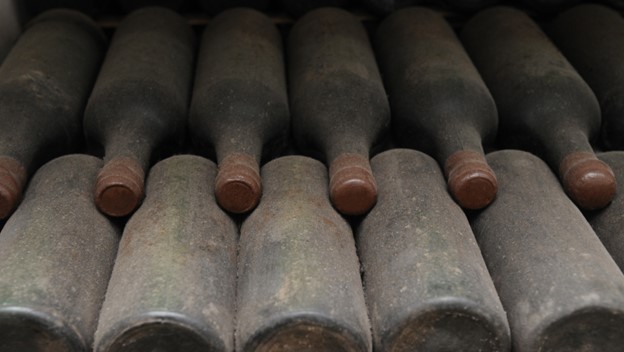Wine and spaghetti were born to be paired together. Throughout Italy, spaghetti is a prized staple both in the most sophisticated restaurants and the most modest of family homes.
Conveniently, Italy is one of the world’s biggest producers of wine, mainly due to its mediterranean climate and soil conditions which allow wine grapes to thrive.
However, for many of us, choosing a wine can be daunting, or we tend to stick to the same one all of the time.
If this sounds like you, you could be missing out on a whole host of delicious wine and spaghetti pairings, as different wines compliment different spaghetti sauces.
Thankfully, we’ve put together this guide to help you out. We’ll cover which wines go with which spaghetti dishes and will fill you in on some of the characteristics of these wines.
What kinds of wine is Italy known for?
With its warm, sunny climate, Italy’s soils harvest a wide range of wine grapes, and as a country it’s best known for the production of signature red wines such as Barbaresco, Barolo, and Brunello.
Among Italy’s favorite white wines you’ll find Pinot Grigio, Prosecco, Saove and Arenis, as well as Lambrusco, sweet Marsala, Amarone, and Chianti.

Different types of spaghetti
Spaghetti is spaghetti, right?
Actually no, there are several types of spaghetti, or at least variations that fall under the same category.
- There’s spaghetti – the thin cylinder noodles most of us are familiar with, usually served with a classic marinara sauce.
- Then there’s spaghettoni, which is basically just a thicker version which is perfect for rich and dense sauces.
- Capellini is a thinner version of the two, sometimes known as “angel hair” pasta, which is perfect with lighter sauces, and is frequently used in olive oil-based dishes.
Different types of sauces
Spaghetti is nothing without the sauce, and this is the main thing you should look at when you’re choosing a wine to pair with your spaghetti dish. These are the staple Italian sauces:
- Classic Marinara Sauce – a tomato-based sauce, usually made with garlic, onions, and some savory Italian herbs.
- Ragù – this is an Italian classic with a rich, herby sauce and ground beef.
- Pesto – usually made with basil and olive oil, with nuts and cheese to provide texture
- Brown Butter – brown butter sauces are exactly that – they’re brown in color and contain plenty of butter, with a simple yet rich taste.
- Alfredo – Alfredo is a creamy and mild choice, usually made with parmesan cheese and served with wider spaghetti.
Red, white, or rose?
When it comes to spaghetti dishes, as a rule of thumb red sauces such as Marinara pair well with red wines, as do meat sauces.
For sauces that are lighter in color, like olive oil-based sauces or creamy sauces such as Alfredo, white wine is a good choice, though sometimes a red wine like Barabera – which has a lot of acidity – pairs well with the rich parmesan flavors.

If the dish contains a contrast of sorts, such as spaghetti with shrimp and marinara sauce, you have two options: either a lighter red or a bolder white will go well in this instance.
What about the level of acidity?
Spaghetti alone is a pretty neutral flavor, so the acidity level of your wine should depend on how acidic the sauce is.
Tomato-based sauces have high acidity and should be paired with a wine that can match this, so look for wines with bright, medium-high acidity. If your wine lacks acidity, it will seem lackluster compared with the rich, acidic tomato sauce.
On the other hand, cream-based sauces have lower levels of acidity so they can be paired with a wine that is equally low in acidity, like a smooth Viognier. Too much acidity will overpower the mild flavors of the sauce and cut through the creaminess.

What about the body of the wine?
‘Body’ is a tasting term that is used to refer to the weight of a wine on the palate, and is commonly referred to in three ways: full-bodied, medium-bodied (medium weight), and light bodied.
The body of the wine – and how light or heavy it is – usually depends on the grape variety, alcohol, tannin, sugar, and extract levels.
A full-bodied wine like Cabernet Sauvignon tastes more smooth and rich, whereas a light-bodied wine will have brighter and more refreshing flavors.

You want to try and match the body of the wine to the dish’s sauce. For example, cream-based, olive oil-based, or pesto dishes will pair well with a wine that is full-bodied, rich, and smooth to match the rich and creamy flavors of these dishes.
Acidic sauces like Marinara and tomato-based spaghetti should be paired with a lighter-bodied wine that will match the brightness of the dish without overpowering it.
Pinot Noir is a good choice as it is medium-bodied and fruit-forward, though if you’re adding meat to the dish you can opt for a wine with a fuller body to match the richness of the meat.
What flavors should I look out for?

For tomato-based spaghetti look for rich berry notes that make a statement, and steer clear of smoother vanilla flavors. Think cherries, boysenberry, and plum, and look out for wines that are described as rich and ‘jammy’ – especially if your sauce contains meat.
For cream-based dishes, you should look for softer flavors in the wine, as these sauces are milder and less acidic.
Look for wines containing notes of stone fruit and light citrus, with a subtle sweetness from honeysuckle and vanilla. The brightness of flavors such as peach, apple, and pineapple also work well.
If you prefer red wine with your creamy spaghetti, look out for wines containing brighter flavors such as strawberry, plum, and blackberry, as well as rounded hints of vanilla and anise.
What about tannins?
Tannins are drying agents that add structure to the wine, making it more astringent or textured. Generally speaking, red wines have higher levels of tannins than white wines.
You don’t need to worry too much about tannins, as all this wine jargon can get a little overwhelming. Most spaghetti dishes pair better with wine that has lower levels of tannins – unless we’re talking meat-based tomato spaghetti dishes.
These require more texture, such as that found in Cabernet Sauvignon.
What about aging?
There’s a misconception that aged wine = better wine. Aging basically refines flavor notes and deepens the complexity of the wine, which can create a smoother, richer, and fuller body, but this isn’t great for creating a wine with bright acidity.
So, when looking at the age of a wine, consider the following:
Tomato-based spaghetti is not necessarily best with aged wine, as we’re looking for acidity.
Aging can add rich, toasted notes such as vanilla, which can be good with meat sauces, but for classic Marinara, you want a bright and acidic wine that will match the acidity of the tomato sauce.

On the other hand, cream-based spaghetti dishes are well-suited to more aged wines. The aging process will create richer, toastier notes that will deepen the wine’s complexity.
For simple cream-based spaghetti, an aged white wine will pair well, though if you’re adding a lot of seasoning or any contrasting flavors, you may prefer something with higher levels of acidity.
Spaghetti and wine pairings
Marinara and Pinot Noir
With this simple tomato classic, try a bright, uncomplicated red wine like this Meiomi Pinot Noir. It’s rich and deeply flavored with notes of blackberry, blueberry, wild berry, cherry, and raspberry and has a silky texture and balanced acidity that perfectly enhances tomato-based dishes.
Meat sauces and Zinfandel
If you’re adding meat to your tomato sauce, try a richer wine like a Zinfandel, which will still contain bright berry notes but has a richer body to match the juicy flavors of the meat.
This Federalist Zinfandel contains flavors of blackberry, raspberry, black pepper, and vanilla, with a touch of clove and caramel.

Cream sauces or pesto and Chardonnay
If your sauce is cream or olive oil-based, a Chardonnay is a no-brainer. This Cave de Lugny Chardonnay is rich and full-bodied, with notes of citrus, white flowers, and honey which will perfectly complement the richness of your cream-based sauce or pesto.
Final Verdict
There are so many different spaghetti sauces out there, and as a result, there are many different wines that pair well with spaghetti. It depends on whether your sauce is cream-based or tomato-based, and whether or not you’re adding meat into the mix.
We know that wine pairing can seem complex, but really it all comes down to personal preference and experimentation.
As a rule of thumb, creamy sauces do well with dry, white wines with low acidity and a full-body as well as smooth notes of vanilla and baking spices.
Red sauces on the other hand are best with wines that are not aged, have a bright acidity and a light to medium body. If you’re adding meat to your tomato sauce, look out for deeper red fruit notes and wines with jam-like flavors.

